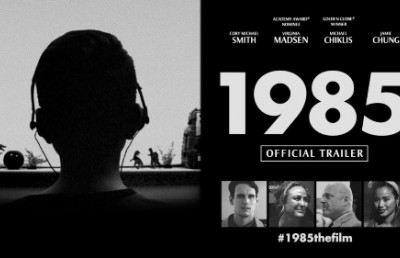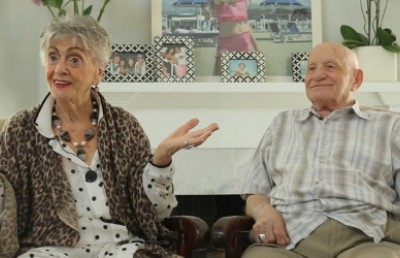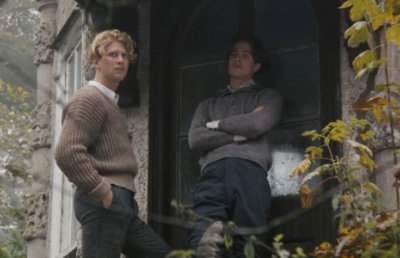But Seeing Through Whose Eyes: Call Me By Your Name and the Mechanisms of Love and Fantasy
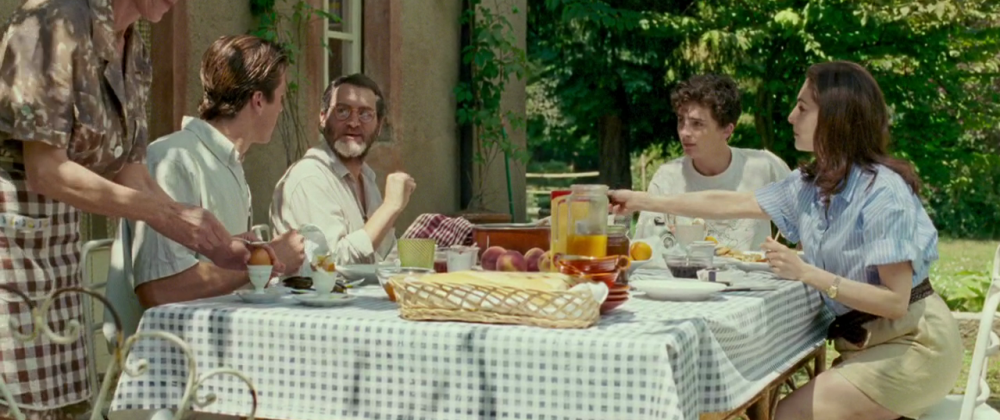
In the riot of critical attention that Luca Guadagnino’s film Call Me By Your Name (2017, Luca Guadagnino) has accumulated since its release just over a year ago, it occurs to me that a crucial aspect has gone unacknowledged. According to its most upfront generic conventions, the film has been read as a coming-of-age drama that tenderly depicts the 17-year-old Elio’s first gay romance, as he bristles at, accepts, and finally falls in love with the 24-year-old Oliver, a visiting graduate student apprenticing under Elio’s professor father. As it expands on the largely contrived, heteronormative conventions of the coming-of-age tale, the film has been read as a confident generic exploration, replacing any ostensible villain or antagonist with the insurmountable anxiety of a deadline, inexorably promising to call Oliver back to the United States and end the film’s central romance. As it compares to two other coming-of-age drama films also released in 2017 – The Florida Project and Lady Bird, whose female protagonists all pursue their self-affirmation while combatting steep gender and class barriers – the film stands as a somewhat tone-deaf parade of bourgeois privilege, and an inadvertent commentary on the asymmetrical distribution of well-being across intersectional class lines. These hermeneutical strands are all surely at work in Call Me By Your Name’s narrative, but it occurs to me that raising any one of them as the film’s thematic fountainhead would be a misstep; I posit, instead, that these critical tendencies are all held in unsteady parallel within the film, as the signifying material of a slightly more elusive argument that runs throughout. Beneath Call Me By Your Name’s (admittedly exquisitely executed) generic shell, inscribed across a robust lexicon of metonyms, metaphors, and other textual artifacts, appears a confident, reflexive argument about cinema itself – its formal strategies of generating and channeling desire, and its historical role producing and disseminating fantasy. Far from an oversight, the film’s repletion with images of bourgeois luxury deliberately situate its commentary in relation to the tropes of an aggressively propagated Western fantasy (Guadagnino’s interviews surrounding the film address this point regularly); if the film does in fact follow a coming-of-age narrative arc, it traces not only a young man’s path to romantic maturity, but also an allegorical rejection of fantasy, and of cinema’s unfulfilled promises.
The cinematic apparatus’ predilection to seize hold of and reshape its audience’s desires has been well understood throughout the medium’s history. The basic nature of cinema’s power has been variously interpreted through aesthetic, semiotic, psychological, and ideological frameworks, to name just a few; from the raw, rapturous aesthetic pleasure Patricia MacCormack calls “cinesexuality” (MacCormack 2) to the comfortable, world-ordering logic Grahame Weinbren identifies in classical cinematic narration (Weinbren 64). Nebulous as these disciplinary affects might be, their ability to enchant audiences has long been acknowledged and analyzed. Cinema’s affective ambivalence is surely on full display in Call Me By Your Name, as the film’s resplendent visuals, erudite soundtrack, and poignant, affecting performances offer no alibi for their targeted, pleasurable play on the viewer’s emotional nerves. For the sake of the present analysis, however, it’s cinema’s propensity to efface its own artifice, and pointedly manipulate the viewer’s perception that interests me.
Of particular interest is an aspect of the cinema that most people above the age of seven believe to be self-evident, yet remains, even still, a live and unusually slippery issue: the way films articulate the division between fiction and reality. In his 1983 book of cinema philosophy, Cinema 1: The Movement Image, Gilles Deleuze observed that, unlike other arts, like painting and sculpture (whose own rhetorical, manipulative capacities have surely also long been understood) “which aim rather at something unreal through the world,” cinema “makes the world itself something unreal […] With the cinema, it is the world which becomes its own image, and an image which becomes the world” (Deleuze 57). While he never goes on to explore this issue in sufficient detail, Deleuze’s articulation here of cinema’s uncanny mimetic reversal, for which the “real world” becomes little more than the raw material of image and artifice, points to a dark undertow to cinema’s allure: the medium’s contrived, enchanting artifice bleeding out from the screen, and crystalizing in the “real” as a guiding epistemological structure. Deleuze’s assessment sharply echoes Jean Baudrillard’s famous notion of the “hyperreal,” an epistemological abyss characteristic of media-saturated cultures, in which the culture’s material realities and ideological fantasies (reality and fiction) fold into one another intractably (Baudrillard 3). While broad and theoretical, these two philosophers’ understandings of image politics resonate with an enduring media-critical tradition intent on making clear the degree of ideological and material power wielded by those who produce cultural works – in this case, filmmakers. Marshall McLuhan famously referred to cinema as “a mighty limb of the industrial giant,” noting film’s tendency to act as a kind of engine for consumerist revelry (McLuhan 295). As early as the mid-1940s, in an influential essay on the holistic economic-industrial constellation that engulfs and influences mass-cultural production of any sort, German critical theorist Theodor Adorno speaks of “the moviegoer, who perceives the street outside as a continuation of the film he has just left” (Adorno and Horkheimer 99) as a prime victim of the mass-media system. Identifying the cinema’s central role in various societies’ (but particularly Nazi Germany’s) ideological inculcation, Adorno contends that “the more densely and completely [cinema’s] techniques duplicate empirical objects, the more easily it creates the illusion that the world outside is a seamless extension of the one revealed in the cinema” (Adorno and Horkheimer 99). According to Adorno, capitalist media lure viewers into an encompassing, inescapable fantasy, in which the sanitized, hyper-consumerist worlds represented by film studios follow the viewer into their everyday life, further inculcating them into the consumerist system, and ever refreshing the capitalist world’s ideological fiction.
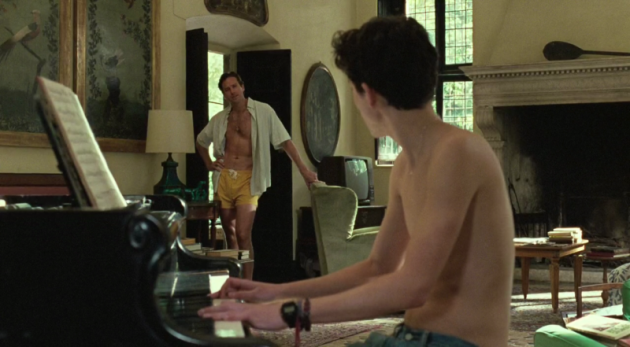
Contrary to Adorno’s argument, though, as films like Call Me By Your Name make clear, cinema is rarely satisfied to simply replicate an empirical ordinary: it is rather wholly intent on expanding upon it, refining its pallet, amplifying its affective charge. Filmmakers have developed, throughout cinema’s (or photography’s) history, a broad lexicon of formal and technological rhetoric pursuant to these ends, crafting with surgical precision visual, sonic, and lexical environments of pure affect and allure. The elision of screen and world of which Adorno spoke allows viewers to see their alienated daily routines through this cast of exaggerated perceptual tropes: an unfocusing of the eyes becomes a camera’s rolling focus; the rise and fall of ambient sound during an afternoon walk appears to follow a narrative arc; a conversation between friends or lovers seems to unroll according to scripted patterns; the haphazard arrangements of objects on a table seems to carry an intentional symbolic value. Benign as it might sound, behind these moments of banal whimsy looms the constant possibility, to quote Weinbren, that “we begin to believe that lived experience that does not conform to this structure is lacking, rather than vice versa” (Weinbren 65), and consequently seek refuge in the culture industry’s ideological fantasy, as Adorno warned. Bracketing this point for the time being, and rerouting this theoretical tangent to the film at hand, I posit that the narrative we’re presented in Call Me By Your Name is one shaped and filtered through just such a hyperreal vantage. We see curious reference to this idea around the middle of the film, in what is perhaps its first concrete disclosure that Call Me By Your Name is a film about filtered perception. In an ostensibly inconsequential scene, during an argument about Italian politics and bourgeois apathy, two of the family’s elderly Italian neighbours mention the (then recent) death of famed Spanish filmmaker Luis Bunuel. In an almost imperceptibly quick exchange, split-second bits of dialogue amidst a rapid-fire lockstep argument, the old woman tells the man “cinema is not the answer”; pithily, he responds, “cinema is a mirror of reality and it is a filter.”
As mentioned earlier, one of the most prominent criticisms the film has received is that its idyllic setting, characters, dialogue, and narrative render its tale of affirmation and growth almost completely unrelatable. The film takes place in an unnamed region of Northern Italy – a land that has undoubtedly stood as the object of much alienated, Western fantastical projection – predominately in the provincial landscape around Elio’s family home, which is old, enormous, and apparently outfitted with a full cast of servants and an peach orchard. Everything is impossibly perfect. In no scene does the environment appear as anything but lush, verdant, sunny, fecund; the (main) characters’ daily routines seem to cycle diaphanously between eating luxurious meals, swimming in ponds, bicycling across the bucolic countryside, and indulging in social levity; every character in the film comes across as an almost cartoonish exaggeration of various fantastical bourgeois ideals – beauty, sociability, intelligence, and status – from Elio’s prodigious musical talent and Oliver’s philological acuity to the family’s unfalteringly pleasant dynamic and Elio’s parents’ impeccable supportiveness. While Oliver and the professor are bound by occasional (although infrequent) professional responsibilities, cataloguing a series of ancient sculptures recently dredged from a nearby lake, Elio doesn’t appear beholden to responsibility of any sort. His days are consumed only by wonderment – playing music, basking in the sun, reading books – floating ethereally through an undifferentiated expanse of privileged youthful fantasy.
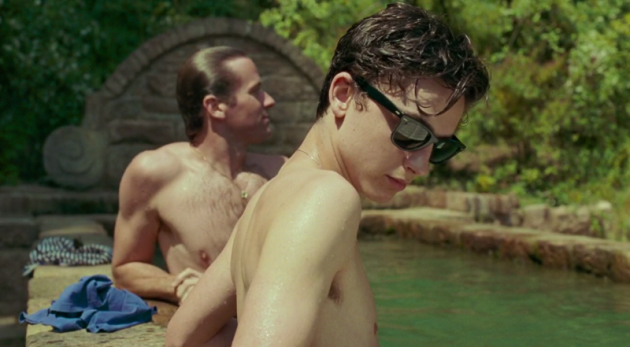
The unbelievably idealized nature of the film’s setting appears immediately alienating, indeed, but before long we begin to see that the very fantastical, fictional nature of its presentation might, in fact, be a key facet of the narrative. Throughout Call Me By Your Name, the role that fictional narratives play in Elio’s life, and in the film’s course, is addressed regularly and overtly. Elio shares with numerous characters that he reads constantly, and throughout the film he is almost always conspicuously shown with a book; he gives Marzia (a consistently confused and unfairly neglected heterosexual, pseudo-interest of his) a book as a gift (to which she later responds “people who read are secretive – hide who they really are”); during a blackout in their home, his mother reads a 16th century fairy tale about apprehension and courage, which then goes on to serve as a conversation point between Elio and Oliver in the next scene, ultimately leading to the moment in which they reveal their romantic feelings to each other. The film’s development seems not only carried along by these piecemeal fictional threads, but, portended by the Italian neighbour’s early aphorism, filtered through them.
Throughout her influential, exhaustive (and exhausting) text Narratology, theorist Mieke Bal insists that, despite the cinematic camera’s often steely sense of perceptual neutrality, cinematic works are nonetheless filtered through a subjective lens no less totalizing than a literary, novelistic narrator. Arguing that “whenever events are presented, they are always presented within a certain ‘vision,’” Bal refers to this filtering perspective as “focalization”. Bal articulates here how, just as a novelistic narrator can be unreliable, overbearingly editorial in their recounting of events to the audience, the ostensibly clear disclosure of cinematic diegesis and narrative progression can, in fact, be wholly delusional, rearranged or fabricated by the perception of a represented character. Nowhere is this more evident than in a scene around the film’s middle, where Elio, sitting under a tree by himself at dusk, wistfully thinks about an absent Oliver. We see an extended shot of Elio simply gazing past the camera (this sort of shot proliferates in Call Me By Your Name, further establishing a sense of Elio as an observer, a spectator); slowly the image is overlaid with a faint, uneven, colourful sheen. Sometime during this sequence’s roughly fifteen second duration, the gossamer haze of green light veers slightly to the right, and we are able to see, for only a split second, the perforated sprockets of a filmstrip – cinema’s most material index appears impressed overtop Elio’s emotional perception. Call Me By Your Name is indeed a pointed exploration of fantastical naïvete, shaped and formed by cinematic schema, and its “focalizor,” the seeing agent whose fantastically intoxicated perspective we’re given access to, is Elio; moreover, the narrative is not only seen through Elio’s eyes as a magical series of events in his stable, diegetic world – the film’s events appear to Elio himself as a film.

There are many ways Elio’s focalization is made manifest in the film’s images, but perhaps the most noticeable is the almost excessive presence of metonyms, symbols, and objects that variously stand in for larger, abstract notions. Nearly every scene in the film abounds with motif objects invested with metaphorical value. As early as the film’s opening credit sequence, whose titles are displayed across a backdrop of photographed statues, we’re introduced to what goes on to be a defining language: symbolic substitution. Objects are shown as the metaphorical carriers of nearly every charge, emotion, affect, and impulse in the film, whether veiled or overt. Early on the in the film, the morning after Oliver arrives (displacing Elio from his room – “my room is now your room” – an early sign of this cinematic world’s fungible logic) he joins the family for lunch. Attacking his soft-boiled egg too aggressively, we see a close-up of yolk forcefully running down the egg’s side, and soon-after an isolated shot of Elio’s face, looking on. The egg recurs numerous times throughout as a stand-in for a latent sexual desire, a polymorphous representational duty shared by manifold other objects, such as bathing suits, shirts, fish, feet, and trees, among others. Cinema theorist Jean Mitry, writing about the primacy and peculiarity of metonym and metaphor in cinema, argues that “in the ‘comparative association’ which generates a metaphorical idea, there is not just a comparison, but an actual association of elements, an exchange of significations, where each borrows from the other” (Mitry 374). In keeping with the inseparable link we’ve established between Elio’s perception and the narrative’s development, we can imagine these objects not as transcendent representations, but as images of Elio’s desire “in its immanence” (Mitry 374) – as Elio’s desire appearing simultaneously to us and to himself, passed forward like a baton between the metonymic relays of his filmic perception. These objects even appear occasionally as extensions of his own body, such as when Elio, Oliver, and the professor first arrive to witness the statues’ retrieval from the lake, and Elio extends one of these statues’ broken arms in a handshake to Oliver. From the opening credits, these statues – human signs, anthropic stand-ins – offer a constant reminder of the almost Platonic mutability that runs throughout Call Me By Your Name. Perhaps the most overt and gratuitous – and most self-referential – of these object stand-in motifs is the film’s repeated focus on peaches, which we eventually see culminate with Elio delicately running his fingers over a peach’s curvaceous contours, before penetrating it with his thumb, and proceeding to ejaculate into it.

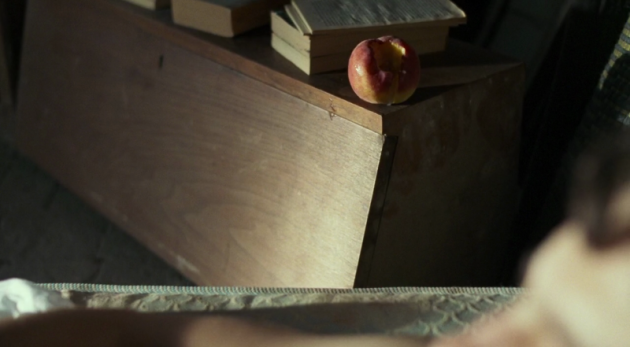
Ambiently informed by lingering traces of the anti-bourgeois criticism popularly mounted against Call Me By Your Name, part of me is inclined to read the shapeshifting nature of Elio’s romantic fantasies as a parallel to his family’s material wealth, his desire behaving like some sort of fungible commodity, endlessly interchangeable. Reminiscent of Theodor Adorno and Max Horkheimer’s remarks on the Enlightenment’s oppressive ideological legacy, whose positivist framework identifies “everything with everything,” “at the cost that nothing can at the same time be identical to itself” (Adorno and Horkheimer 8), such as the lateral comparability of written words or the flattening horizon of capitalist exchange value. Alternately, following Mitry’s comments on metaphoric translation, though, it strikes me that Call Me By Your Name’s polymorphous treatment of desire might resonate more finely with philosopher Brian Massumi’s articulation of affect and virtuality. Following a Deleuzian tradition, Massumi writes extensively of the amorphous, impersonal, unformed powers that run through and between people, and that make up the raw material of emotion (which give these powers shape). Speaking of this para-cognitive force like a kind of shapeless electrical charge being transmitted through mass-media systems (such as cinema) Massumi writes, “media transformations are breaches of indetermination. For them to have any specific effect, they must be determined to have that effect by apparatuses of actualization and implantation that plug into them and transformatively relay what they give rise to” (Massumi 44). The objects that carry Oliver’s and Elio’s affects back and forth, then, could be seen as just these apparatuses, giving variously actualized forms to a single feedstock of affective charge; parallel to the characters’ “individual” desires, we might also imagine the cinematic apparatus itself as serving a similar function, both generating and channeling, giving actualized shape to the swirling, unformed affects of Elio’s adolescent fantasy.
We see this fungible affective drive – the pervasive interchangeability previously addressed –most clearly epitomized in a single one of the film’s operations: the linguistic play referenced by the title, Call Me By Your Name. As Elio and Oliver are lying in bed, wrapped around each other following their first time having sex, the camera looking down on them from above, placing them up-side down in the film frame, Oliver gently whispers to Elio, “call me by your name and I’ll call you by mine”. This gesture is undoubtedly quite tender and poetic, allowing Elio and Oliver to hear their own names spoken to them, charged with their lovers’ desire for them — allowing the other to see their own desire reflected upon them. Cinema theorist Patricia McCormack describes her neologism, cinesexuality, as “the desire which flows through all who want cinema as a lover” (MacCormack 1). Borrowing extensively from Deleuze’s film philosophy and theories of desire, MacCormack speaks of the cinematic, regardless of its audio-visual-lexical content, as a kind of destabilizing, para-subjective force that disembodies the viewer; like sexual desire, or sexual intercourse, cinema’s barrage of sensual, sensory affects carries the potential to take viewers outside of themselves, reverse the poles of subject and object — to turn the viewer’s own spectatorial fascination itself into the object of their attention, affect, and desire. MacCormack argues that “our own capacity to affect ourselves, to exceed our own signification, becomes in the act and affect of cinematic viewing,” going on to refer to cinematic desire as “the gift of the outside-of-self to self” (MacCormack 61). Just as we’ve seen the film’s metonyms as cinematic vehicles, immanently generating and circulating Elio’s desire, here we see this projective logic jump to a higher shelf, Elio projecting his entire subjectivity into the cinematic apparatus. While it fails to encompass the shape of Elio’s fantastical intoxication entirely, cinesexuality offers a lucid framework through which to examine focalization of this film, particularly in its most basic wording – “those who want cinema as a lover” – as this relationship ultimately governs the film’s entire romance. (Given MacCormack’s insistence that cinesexuality operates irrespective of sex or gender, the notion’s direct relevance to this analysis of a specifically queer romance might seem suspect; however, in his equally Deleuzian analysis of queer cinema, The Desiring-Image, Nick Davis points out the fundamental queerness of Deleuze’s notion of desire, as it contravenes the legal, medical, and generally normative striations imposed on the sexed and gendered body, existing in an irreducible place of above or between.) Elio serves as the film’s focalizer, voyeur, and spectator; Oliver – the object of Elio’s spectatorial gaze – serves as a reified embodiment of cinema itself, as both screen and camera.
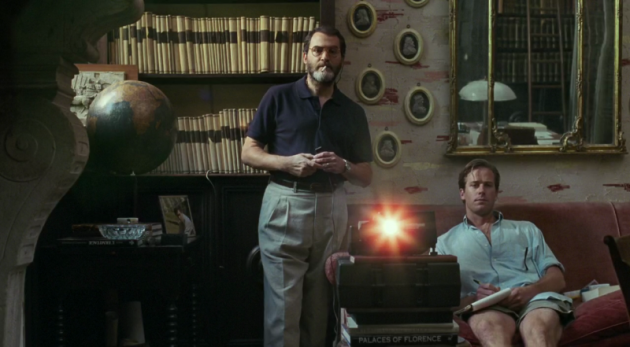
Oliver’s very presence at the family’s home is temporary, iterative – he’s part of a lineage of yearly visitors, coming to work with the professor for six weeks each summer. He’s spoken of as a kind of episode: “he’s better than the guy that came last year”. Whether filmic or televisual, Oliver appears most overtly as a screen for Elio’s desires – like so many of the film’s elements, a kind of chimeric distillation of white, bourgeois fantasy. He’s tall, fit, handsome, educated, gregarious, and intelligent – nonchalant but affectionate, fawned over by the village’s women, yet miraculously reciprocating of the young, thin, awkward Elio’s love. Near the film’s end, as the two men take a final trip together, we’re offered another of the film’s direct references to cinematic materiality, as the narrative’s focalization appears to shift momentarily to Oliver (while Elio is asleep). As he reminisces about their time together, Oliver’s memories appear to him in filmic negatives, and we’re shown flashback scenes with inverted colours; rather than simply Elio’s screen, Oliver curiously appears as the film’s camera as well – his final line in the film, spoken to Elio over the phone several months after his departure, “I remember everything,” offers a final cryptic affirmation that he’s been recording all the while. Yet as a figure in the film he is reducible to neither screen nor camera. As I understand Oliver’s role in the film, as a polymorphous embodiment of cinema’s abstract assemblage, he resembles what theorists Alberto Toscano and Jeff Kinkle refer to as “a materialist prosopopoeia” – a “rhetorical device” used “to tackle the representability of those abstractions which, albeit invisible and intangible, and existing as complex processes and relations, not things, nevertheless determine, in generally overpowering ways, the actions of individuals and collectives” (Kinkle and Toscano 43). Bearing a critical edge reminiscent of Adorno’s view of cinema, we might imagine Oliver as representing Western fantasy’s (ideology’s) epitomized form, an unreal and seductive force, catering to the insular, narcissistic dreams of a few while alienating the many (in this case, the film’s neglected young women.) However, Call Me By Your Name’s sign system is more complex than this simple moral condemnation, and we can just as easily imagine Oliver’s role in the film countervailed by MacCormack’s beautiful description of the cinema, under her rubric of cinesexuality, as “a lover we take, a becoming alliance, an image with which we fold and to which we consent, giving the gift of self we cannot give, to die in the ecstasy of the outside-of-self” (MacCormack 62).
Beholden to the coming-of-age genre’s dictates, towards the film’s end, as the looming deadline of Oliver’s departure draws closer, a shadowy edge seems to wade into Elio’s previously unfettered reverie. When Oliver discovers the semen-filled peach on a bedside table, Elio becomes panicked and distressed, his youthful naiveté suddenly appearing alien and embarrassing; during their final trip together, Elio vomits from drinking too much, his previously boundless excesses finally registering in a bodily sense. His relationship to fantasy becomes complicated or strained. While their final moments together aren’t much less formally idyllic than the rest of the film, the departure’s gravity begins to weigh on their interactions. Their approaching separation seems to bring with it a concomitant weakening of Elio’s intoxicated bond, an awareness that the fantastical cinematic apparatus, now attached to him like a prosthetic, could never last; that the wonders of seeing one’s life as a film, of falling in love with cinematic reveries, immolate upon contact with the world’s fraught realities, or calcify, through ideological indoctrination, into capitalist alienation. The film’s now-famous final moments – a static shot of a teary-eyed Elio, staring into a fireplace, and directly into the camera, for several minutes – is a last, subtle, but forceful consummation of Elio’s extension past youthful fantasy: if we, as spatialized viewers, imagine the camera’s position in this scene (as the film’s repeated references to filmic materiality invites us to do,) this final moment places the camera directly in the fire, with Elio tearfully watching his fantasy’s object burn. Throughout this scene, and much of the credits, the audio track gently returns to an incisively strategic, yet disorienting lyric: “is it a video?”
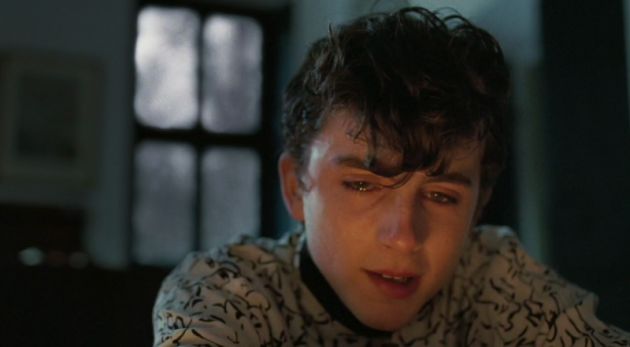
To reaffirm, I assume uncontroversially, a point alluded to in the introduction, Call Me By Your Name operates at once on numerous parallel registers, and as such comes across as many different things to many different people. Even with a framework as firmly rooted in cinematic meta-discourse as we’ve employed here, we’re left with many options in our interpretation. Guadagnino’s fixation with material luxury, coinciding as it does with a representational paradigm of travel ads and resort brochures, might rightly inspire a Marxist, critical-theoretical injunction that the cinema-intoxicated perspective on view here acts as a tacit endorsement of the asymmetrical pleasures available to those select upper-class subjects who might enjoy them. Similarly, the film’s gregarious use of metonymy – its depiction of an ultimately fungible emotional register – might be seen to coincide too closely with Enlightenment or capitalist ideals to be deemed critical or otherwise uplifting. Conversely, one might look to the ultimate failure that awaited these bourgeois fantasies – Oliver’s departure, and Elio’s dejection – as a subtle disavowal of bourgeois complicity; a kind of cautionary tale, akin to Roland Barthes’ warning that the real danger of capitalist media is when the audience begins to genuinely identify with the content: “it is as from the moment when a typist earning twenty pounds a month recognizes herself in the big wedding of the bourgeois that bourgeois ex-nomination achieves its full effect” (Barthes 141). And rather than seeing the film’s metonym as a kind of commodified logic, akin to exchange value, we might follow Massumi’s belief that a greater sensitivity to “affect, potential, and actualization may aid in finding countertactics” (Massumi 44) to an oppressive capitalist system. As might be clear from my explanation, I find myself continually vacillating between these two poles.
Perhaps in a particularly expanded sense, Elio’s gradual disavowal of cinema’s domineering perceptual influence serves as a kind of elegy to cinema’s relegation at the hands other media, which, by 1983, was already well underway. But while it is generally acknowledged that cinema long ago ceded its place as the West’s dominant cultural form, first to television and then to the internet (Shaviro 1), its formal, cultural, and ideological influence persists still in each of its mediatic progeny, and arguably stands as the genetic ancestor to the past century’s entire ecosystem of moving-image media. Between the film’s diegesis, set in 1983, and its release in 2017, it might be seen as speaking to both eras at once: Elio’s initial fantasy countenancing a bygone mediatic credulity on one hand, and his passage to perceptual disillusionment offering parallel to the epistemological snares that litter present-day media on the other. Call Me Your Name’s signification will surely remain ambiguous and ambivalent, replete with variously branching premises and contradictions, but in its closing image, as Elio sits in front of the fireplace, watching the camera burn, I identify a braced warning: that even by 1983, the cinema’s parasitic legacy had already spread to various other media; that its epistemological conditioning was already diffuse in the atmosphere; that it cannot help but entice and it cannot help but betray; and that a tortured ambivalence necessarily marks the present and future of mediatic spectatorship.
Bibliography
Adorno, Theodor, and Max Horkheimer. Dialectic of Enlightenment. Trans. Edmund Jephcott. Stanford University Press, 2002.
Barthes, Roland. Mythologies. trans. Annette Lavers. Hill and Wang. 1972.
Baudrillard, Jean. Simulacra and Simulation. Trans. Sheila Glaser. University of Michigan Press. 1995.
Davis, Nick. The Desiring Image: Gilles Deleuze and Contemporary Queer Cinema. Oxford University Press. 2013.
Deleuze, Gilles. Cinema 1: The Movement Image. trans. Hugh Tomlinson and Barbara Habberjam. University of Minnesota Press. 2013
Massumi, Brian. Parables for the Virtual: Movement, Affect, Sensation. Duke University Press. 2002
MacCormack, Patricia. Cinesexuality. Ashgate Publishing. 2008
Mitry, Jean. The Aesthetics and Psychology of the Cinema. trans. Christopher King. Indiana Unviersity Press. 2000
Shaviro, Steven. Post Cinematic Affect. Zero Books, 2010.
Toscano, Alberto, and Jeff Kinkle. Cartographies of the Absolute. Zero Books, 2015.
Weinbren, Grahame. “Ocean, Database, Recut,” in Database Aesthetics: Art in the Age of Information Overflow, edited by Victoria Vesna. Minneapolis: University of Minnesota Press, 2007. p. 61-85



